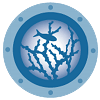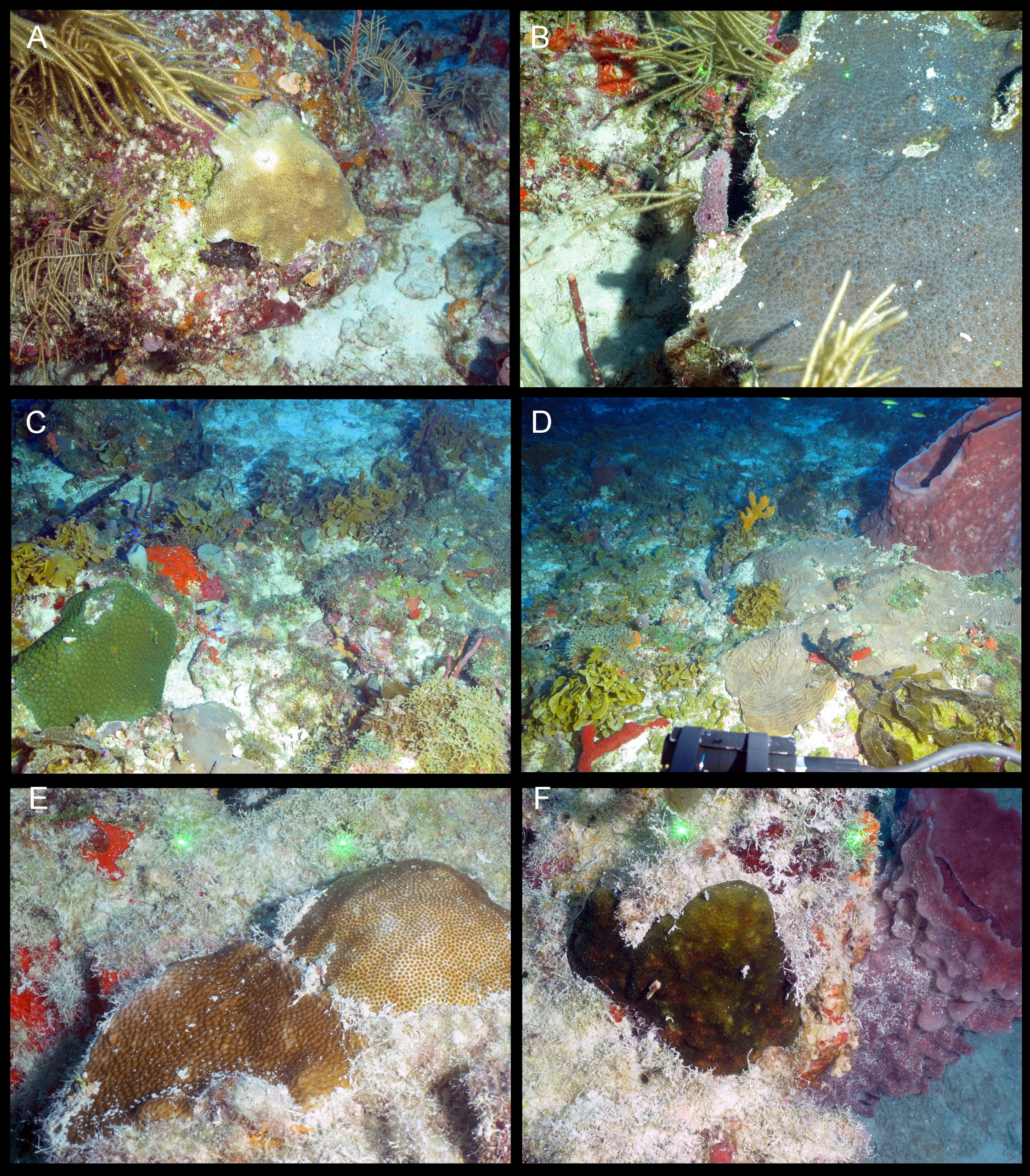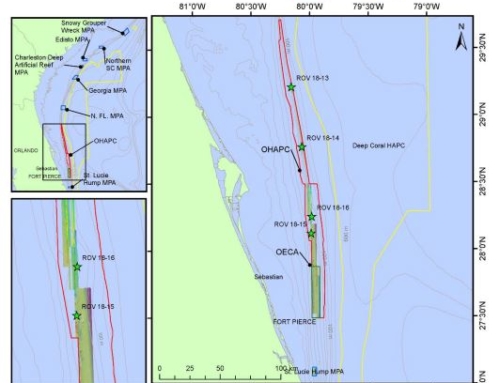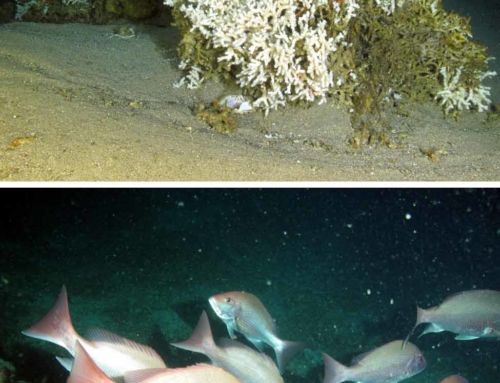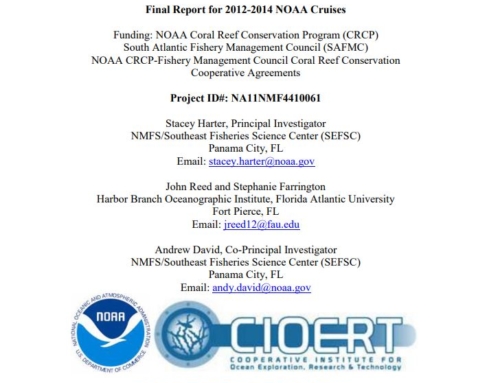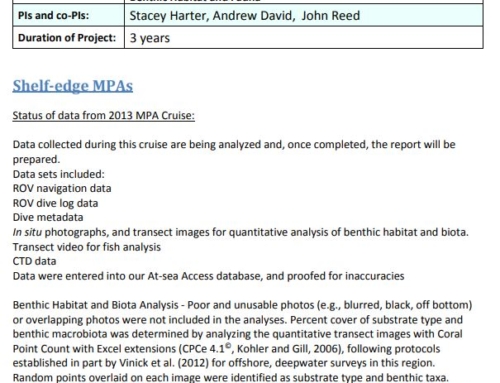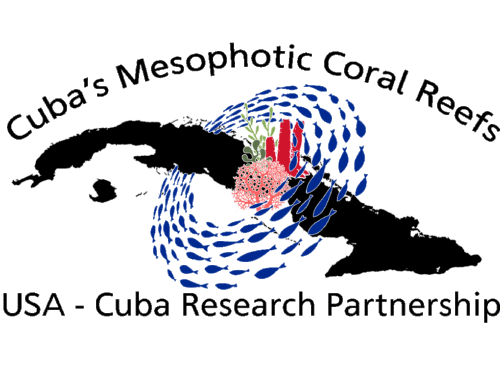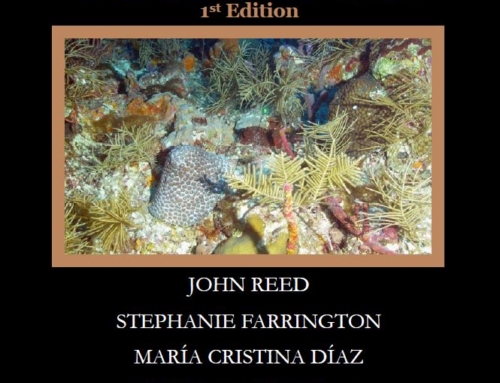Project Description
Characterization of the Mesophotic Coral Reefs in the Florida Keys National Marine Sanctuary
John K. Reed, Stephanie Farrington, María Cristina Díaz, Shirley A. Pomponi, Dennis Hanisak, Josh Voss
Introduction
A 17-day research cruise was conducted to the Florida Keys National Marine Sanctuary (FKNMS), August 12-29, 2019 by the Cooperative Institute for Ocean Exploration, Research, and Technology (CIOERT) at Harbor Branch Oceanographic Institute, Florida Atlantic University (HBOI-FAU) aboard the University of Miami ship R/V F.G. Walton Smith.
Two legs of the expedition were conducted. Leg 1 (August 13-20, 2019) consisted of Mohawk remotely operated vehicle (ROV) dives with the primary objective to document and characterize the benthic habitats, benthic communities, and fish assemblages of the mesophotic (30-100 m) coral ecosystems and deep rariphotic (>100 m) zones within and adjacent to the protected areas within the jurisdiction of the Florida Keys National Marine Sanctuary (FKNMS) (Figs. 1-3, Table 1). Additional dives that are not included herein were made on some shallow reefs (<30 m) within the Tortugas Ecological Reserve (TER) and also in Pulley Ridge HAPC in the Gulf of Mexico. Leg 2 consisted of technical scuba dives conducted within the FKNMS and TER to collect corals and sponges for population genetics studies and are not included in this report. The first report related to these coral connectivity assessments can be found in Sturm et al. 2021.
The Florida Keys National Marine Sanctuary (FKNMS) was established in 1990 includes 13 sanctuaries and two marine monuments with in the 3,800 square miles designation. Restrictions vary within the region but include sea floor impact (e.g., mining, bottom impact fishing, anchoring) and large shipping traffic (Florida Keys National Marine Sanctuary and Protection Act, Pub. L. 101–605; 16 U.S.C. 1433 note; https://safmc.net/newsletters/proposed-changes-to-florida-keysnational- marine-sanctuary/). The Tortugas Ecological Reserve is made up of the northern TER encompassing Sherwood Forest and the southern TER encompassing Riley’s Hump and part of Miller’s Ledge. The regulations in the TERs include the same restrictions as the overall NMS but 3 are expanded to include ship discharge, and all fishing and diving and snorkeling are prohibited in the southern TER (https://floridakeys.noaa.gov/zones/ers/welcome.html).
This report is a step towards the characterization of a highly diverse and poorly known component of these unique deep-water benthic communities in the mesophotic zone. In addition, the accompanying publication (Reed et al., 2021; Photo Identification Guide of the Benthic Taxa Inhabiting the Mesophotic Reefs of the Florida Keys National Marine Sanctuary) represents the first taxonomic identification photo guide to the most common benthic taxa observed while exploring the mesophotic reefs of the FKNMS. From 2011 to 2019, NOAA Fisheries and HBOIFAU CIOERT also surveyed with ROV the shelf-edge and deep-water Marine Protected Areas (MPAs) and deep-water Habitat Areas of Particular Concern (HAPCs) of the southeastern US extending from South Florida to North Carolina at depths of 48 to 1240 m. This resulted in a photographic field guide of the sponges associated with these reefs (Diaz et al., 2021). Many of these species are within the mesophotic and rariphotic depth zones. We also have three photographic field guides for the mesophotic reefs of Cuba, including a sponge guide (Diaz et al., 2019), a macroalgal guide (Martínez-Daranas et al., 2018), and fish guide (David et al., 2018). Some of these species will overlap with what we have found on the FK mesophotic reefs.
The data from this 2019 cruise establish current baseline information to be referenced and compared to future research cruises to identify the long-term health and status of these important ecosystems. These data are made available to the FKNMS, SAFMC, NOAA Fisheries, NOAA Deepsea Coral Research and Technology Program (DSCRTP), NOAA Coral Reef Conservation Program (CRCP), NOAA Mesophotic Reef Ecosystem Program, and NOAA National Marine Sanctuaries program to assist management of these habitats and key species.
Previous Studies of the Deep-water Reefs of Florida Keys
The first published study of the mesophotic reefs within the current region of the FKNMS was made with the HBOI research submersible, Johnson-Sea-Link I in 1979 (Jameson 1981). This was before the term “mesophotic ecosystems” was coined. Several studies in the 1970s and 1980s provide details of various reefs along the Florida Key reef tract. In the early 1970s, Harbor Branch Foundation had a field station in Key Largo which provided some of the earliest studies of the reefs in the upper keys; Antonius (1972) made the first surveys of the reefs in and around Pennekamp Coral Reef State Park (now part of the FKNMS). Although most of these studies have been on the shallow water reef systems, Voss et al. (2002; first published 1983) detailed the reefs off Key Largo and mentioned the deep (mesophotic) reefs off Molasses Reef. Bohnsack (2002; first published 1983) detailed Looe Key reefs but these do not extend beyond 30 m. Dustan (1988) described the changes of the reef community at Carysfort Reef (off Key Largo) between 1975 and 1983. Dustan’s study compared 21 permanent transects at depths between 0 and 22 m showed decrease in coral abundance due to sedimentation and disease.
Previously, HBOI-CIOERT surveyed with ROV the region between the TER South and the western border of the FKNMS (Reed et al., 2016, 2017). These dives only found mostly soft bottom habitat, along with some hard bottom reef habitat primarily at depths less than 30 m in this region. The western region of the northern TER is also shallow reef habitat (Reed et al., 2016, 2017), but the west facing fore reef slope of TER N abruptly ends in flat sand around 30- 35 m. We also have described ROV and submersible dives within the rariphotic zone of the southern 4 region of TER South, primarily along Miller’s Ledge south of Riley’s Hump (Reed et al., 2016, 2017). Weaver et al. (2006) first described the deep-water reef fishes and multibeam bathymetry of this region of Miller’s Ledge. Seaward of the Florida Keys reef tract and mesophotic reefs is the Pourtalès Terrace which is an exposed hard-bottom platform at depths of 200-450 m and consists of high-relief mounds, rocky escarpments, deep-water sinkholes and the only known deepwater Lophelia coral reef off the Florida Keys (Reed et al., 2005; Reed et al., 2006; Reed et al. 2012; Reed et al., 2014; Walker et al. 2021). This diverse deep-sea coral ecosystem is dominated by stylasterid hydrocorals, octocorals, and sponges that supports recreational and commercial fisheries.
Reed, J.K., S. Farrington, M.C. Diaz, S.A. Pomponi, M.D. Hanisak, J. D. Voss. 2021. Characterization of the Mesophotic Coral Reefs in the Florida Keys National Marine Sanctuary. NOAA CIOERT Report, 222 pp. Harbor Branch Oceanographic Institution Technical Report Number 198.

